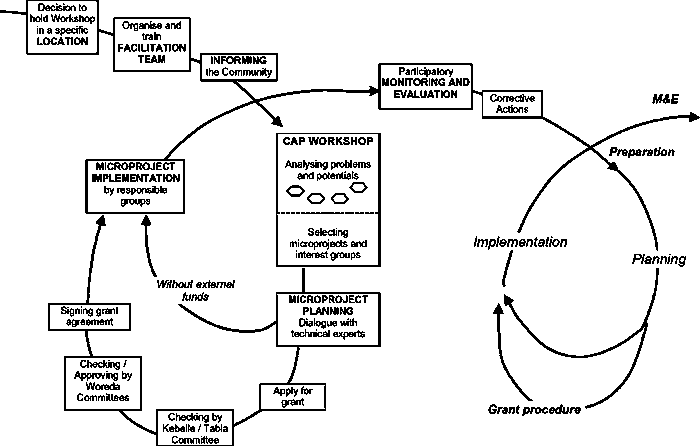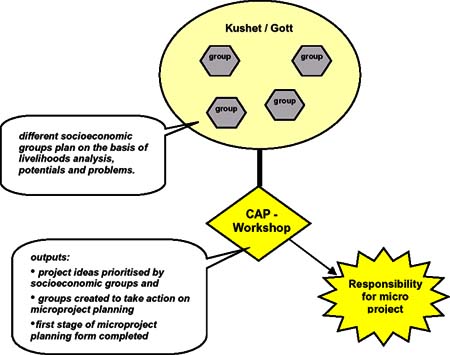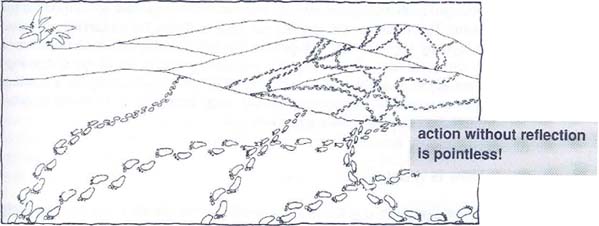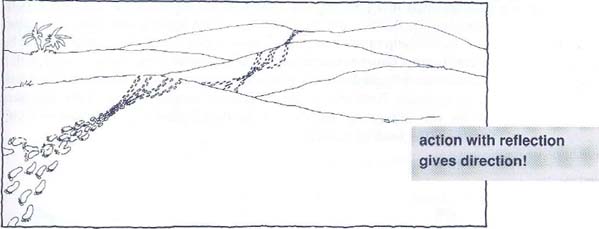These guidelines are for the use of Facilitation Team members working with the project “Improving Nutrition and Household Food Security in Northern Shewa, Amhara Region and Southern Tigray” (GCP/ETH/056/BEL).
The development objective of the project is to improve the nutrition and food security status of selected communities in four woredas, namely Lalomama and Gera-Keya in North Shewa and Enderta and Hintalo Wajerat in southern Tigray. The project will apply a bottom-up, participatory community action planning process, in line with Ethiopia’s decentralisation process, to ensure that locally appropriate micro-projects can be identified and implemented to improve the nutrition and food security situations of the rural poor.
The diagram on the following page provides an overview of the Community Action Planning (CAP) Process. The core components of the process are:
Participatory Monitoring and Evaluation.
CAP is an on-going process. CAP workshops will be held in the 10 kushets/gotts of the four project woredas throughout the life of the project. They will be organised on a quarterly basis and last for about two days. Participatory monitoring and evaluation is essential as part of the second and subsequent planning cycles. There may be more than one CAP workshop per quarter in a kushet/gott, if that is necessary to achieve appropriate geographic coverage and participation of all residents in the area.
The CAP process will bring along new responsibilities and roles for all those involved:
People will no longer be "beneficiaries", as they become active planners and owners of their own micro-projects;
Subject Matter Specialists will act as technical advisors and facilitators of micro project planning groups;
Committees at Tabia/Kebelle and Woreda levels will be responsible for checking, approving and channelling micro-project proposals that require grant funding;
Development Agents, Home Agents and trained community members will have important facilitation roles for group promotion.
COMMUNITY ACTION PLANNING PROCESS

CAP will build on and support the capacity of existing and new community based organisations, including service co-operatives, small community groups and labour sharing or other social support mechanisms. Kushet/Gott level development committees may be developed to represent the interest of the different community groups and promote, advise and monitor microproject planning.
The overall speed of community action planning will be largely determined by the capacities of microproject groups to gradually assume a more active role in the CAP process. The CAP Process should promote mutual accountability between community, officials and existing committees at different levels.
The major objectives of a CAP workshop are:
To provide an opportunity for different socio-economic groups to discuss and analyse their livelihoods, including problems, causes of problems, livelihood strategies and potentials that could help them solve problems.
To undertake some initial planning steps for microprojects by identifying interest groups and who will be responsible for arranging follow-up activities.
To build people’s capacity to participate more actively in development planning, relating to issues affecting their community as a whole and their individual livelihoods.
Community Participation
It is very important to encourage a wide participation of different community members in CAP workshops. All residents of selected kushets/gotts should be informed, well in advance, of the objectives of the CAP process in general and the CAP workshop in particular. People need to know that they are invited to get involved voluntarily and actively in planning and implementing projects to improve their lives, particularly regarding nutrition and food security. It is particularly important to ensure the participation of female headed households, male headed households without oxen and landless young people as these were found to be among the most malnourished and poorest households in the four woredas.
Informing the Community
To ensure full participation in workshops, communities must be well informed about the project and the CAP process. Organisers must use both the normal information channels that operate in the kebelles/tabias, e.g. development agents, home agents, churches, as well as holding special Information Days to which everyone in the area is invited, before conducting CAP workshops. It is also recommended that posters and leaflets explaining the project and CAP are distributed in the area, e.g. in schools, shops, cooperatives and churches, for people to read or ask about.
Facilitation
The CAP workshops will be facilitated by a CAP Workshop facilitation team. This team will normally consist of educated people drawn from the community itself, together with representatives of kebelle/gott and woreda level institutions and sector offices. It might also include people from the regional level.
There should be a minimum of nine people in a team, at least two of whom should be women. If possible more women should be included. During the CAP workshop, one team member will be the team leader and the other eight team members will rotate their roles and tasks as facilitators and note-takers. The team should be well organised and will be responsible for preparing the CAP workshops, conducting information meetings before the CAP workshop and facilitating the CAP workshop itself. The team will also be responsible for documenting the CAP Workshop results for further use by community groups and the kebelle/gott and woreda levels committees.
This diagram summarises the nature and outputs of a CAP workshop:

The Vision
The long term vision underpinning the CAP process is that eventually community groups might also directly plan micro projects and, if needed, seek technical or financial assistance through the Kebelle/Tabia Committee to the Woreda Coordinating Committee, without having to wait for the next organised CAP workshop to initiate the planning process. This is especially true of income-generating activities which are ultimately individual or small group initiatives and microprojects are more about obtaining the necessary knowledge and skills.
Summary of the key principles of CAP workshops:
|
|
Toolbox: Tools and examples are provided in Part 2 of these guidelines to help you prepare and run a CAP workshop.
The main result of a Community Action Planning workshop should be the decision to solve one or more of the community’s problems through the preparation of microprojects. A microproject is simply a specific activity designed to solve a specific problem, e.g., spring protection to provide clean drinking water, latrine building to improve sanitation and hygiene practices, vegetable production to improve nutrition, etc. Microprojects differ, however, in how they may be planned, implemented and funded and different procedures will be applied to different categories of project.
Microproject planning involves working out resource requirements and time bound action plans. Plans will be started in the CAP Workshop but continued by interest groups with the help of individual experts or members of facilitation teams. If the group is able to provide all the resources needed and only require technical advice, they can proceed directly to implement the microproject. If extra funds are required, the FAO/BSF Community Development Fund is available to provide grants for some types of micro projects. Grants could be available from other sources to finance projects which do not meet the FAO/BSF criteria. Grants are not available for income-generating activities, except to subsidise the cost of capital equipment for a group-run enterprise which is considered to have particular value in relation to nutrition and food security. Individual households must apply to local microfinance institutions for loans or buy inputs on credit from the local cooperatives to finance income-generating enterprises or they could start a savings and credit group.
There are three categories of microproject.
Category 1 Community Microprojects
A Community Microproject is one which, when completed, benefits more than a single household. A community microproject creates community owned property which must be maintained by all those who benefit from it. To plan and implement this type of microproject, a management committee must be nominated from within the community to organise the people involved.
Examples of community microprojects:
1. Improving community water supplies - spring protection, well construction, pond construction and other types of water harvesting for communal purposes including water for human consumption, for watering livestock and for crop irrigation.
2. Improving health facilities and availability of medicines, birth delivery kits, resources for HIV/AIDS prevention, dietary supplements.
3. Improving sanitation - communal latrines and rubbish disposal sites.
4. Reducing soil erosion by community action.
5. Community tree planting for fuel wood and/or erosion control.
6. Community nursery for tree seedlings.
7. Community cattle crush.
8. Establishment of a new cooperative shop to supply farm inputs and other essential goods.
9. Establishment of a savings and credit group.
Category 2 Household Microprojects
A household microproject is one which benefits an individual household. Any property created belongs to the individual household and is maintained by them. Planning and implementing this type of microproject is, therefore, a matter for an individual household and does not require community organisation. However, there is a role for a community group in household microprojects which is explained below in relation to the two types of household microproject that have been identified.
Type A Improving living conditions
Type A household microprojects are intended to improve living conditions for an individual family in ways that can contribute to better health and better food security. Examples of this type of microproject include:
1. Individual latrines.
2. Household water harvesting schemes.
3. Individual fuel wood plots.
4. Fuel saving stoves.
5. Mosquito nets.
The primary role for a community group in relation to planning this type of microproject is to identify and select those households which would benefit from labour-saving interventions or access to a latrine or water harvesting equipment but who are unable to undertake or finance the projects without help. The group or committee will have to agree to the qualifying criteria as well as the actual selection of households benefiting from this microproject. Group representatives may then apply for a grant from the CDF in order to help these most vulnerable households.
Type B Improving incomes
Type B household microprojects are intended to improve the income-generating ability of individual households. A wide range of farm and non-farm options are possible in the project area. Households will be expected to take part in technical and business training and implement improvements to current enterprises or introduce new ones. The role of the community group will be to ensure that this technical and business training is available and that members of vulnerable households are able to participate in the training.
People will also need access to the inputs they require to implement their enterprise plans and may need to obtain these on loan. Thus the community group will need to ensure that appropriate inputs are available and can be purchased on a loan basis if required. This may involve encouraging the existing local cooperative management committee to undertake training to improve their business planning. If this is done, a grant may be requested from the Community Development Fund to enable the cooperative society to purchase and sell on cash or credit terms the required materials.
The community group should also ensure that target groups of vulnerable households are not excluded from cooperative services by their inability to pay membership fees and purchase share capital. Cooperative Societies receiving working capital from the CDF will be expected to provide deferred share payment schemes, which enable poor people to pay in instalments. Another alternative is for cooperatives to accept joint membership from small groups, which may be particularly helpful to women. Development Agents should ensure that vulnerable households are confident and able to take part and express their views in meetings of society members.
A working capital grant to a cooperative will remain as equity within the cooperative, as long as credit sales are fully recovered. The capital will thus “revolve” and will be available for the purchase of further stocks of inputs. If the membership of a cooperative grows and the input supply business is well managed, a second request for additional working capital from the CDF can be considered.
A cooperative obviously cannot stock livestock to sell. Therefore, to make capital available for livestock purchases, there will be two options:
1. A cooperative may apply for a loan fund, provided the appropriate application, approval, disbursement, recovery and accounting procedures are in place. This fund can then be used to extend loans for livestock and potentially other activities as well.
2. A group of householders can organise themselves as a savings and credit group and once they have established workable procedures they can apply for a grant to increase their funds and enable them to extend loans for livestock purchases. This would be considered a Category 1 microproject.
Group Enterprises
It may be valuable for small groups of people, particularly women, to work together on an enterprise with a view to sharing any profit made between them. A group enterprise must be planned just like an individual business. It has to be profitable or it will fail. Market research must be carried out and costs and returns estimated to establish the feasibility of the enterprise.
Advantages of running an enterprise as a group are:
Group members can share their skills, time and resources together to make something work.
Work can be divided amongst the group members, making the best of the time everybody has available.
It is easier for groups to get assistance from outside - training, grants, loans, advice from rural development agencies, etc.
Groups give members more self-confidence, especially women.
Decisions taken in a group are often better and more realistic than those made by individuals.
However, problems can arise in group enterprises:
Deciding who will do what is not easy - it can cause arguments.
Decision-making in groups takes longer and people do not always agree.
One or more group members may contribute less than others in time or money but still want an equal share of profits.
Nobody likes sharing losses.
Credit
Individual households may consider that they need credit in order to implement their income-generating plans. This decision should only be reached after careful financial planning and consideration of the possibility for self-financing.
The options for obtaining credit will be to approach a local microfinance institution for a loan or to buy inputs from a local cooperative on a credit basis. In either case the householder will have to comply with the rules and conditions set by the institution concerned. Guidance and assistance with filling application forms can be given by development agents and other government staff.
The decision of a cooperative society as to whether a member should be able to purchase inputs on credit or not and the interest rate policy and repayment terms that will be applied, will be the independent decision of the cooperative. The role of the community and the Development Workers will be to ensure that vulnerable households have been given sufficient support to produce practical and viable plans for enterprise development, so that they do qualify for credit.
If a group wants to get a loan or purchase inputs on credit for their enterprise, it must approach a local microfinance institution or cooperative in the same way as an individual. If a group enterprise would have a nutritional benefit for the wider community, a grant can be requested from the CDF to contribute towards the cost of fixed assets such as machinery or equipment. This would be treated as a Category 1 microproject.
Toolbox
Tools and examples are provided in Part 2 of these guidelines to help technical advisers assist communities with microproject planning and teach households about business and cash flow planning.
Applications
Once planning processes have been completed and a community group has decided to ask for support from the Community Development Fund, an application form must be completed and submitted to the Kebelle or Tabia Food Security / Development Committee.
The responsibility of this committee will be to check:
1. that appropriate microproject planning forms have been satisfactorily completed by the community group;
2. that sufficient technical advice has been obtained by the group;
3. that the microproject meets a priority need related to nutrition or food security identified during a CAP workshop;
4. that vulnerable households have been identified and will benefit from the impact of the microproject;
5. that an adequate community contribution is being made.
An adequate contribution has been specified in the project document as 10% of total microproject costs. However, it is often quite meaningless to apply figures to materials or labour provided in kind. Therefore, the judgement of “adequate” should be based on the following questions:
How much time has the community group already devoted to planning activities?
Are the activity plans that have been prepared sufficiently comprehensive and detailed?
Has the community taken full responsibility for the planning and future implementation of the microproject?
Have all the people expected to benefit from the microproject participated in the planning?
Are the community proposing to make physical contributions in the form of labour or materials?
Are the community proposing to make cash contributions?
Have the community proposed a maintenance plan for which they will take responsibility?
The committee have the right to refer back to the applicant group and request amendments or further information before completing the recommendation section and forwarding the application to the Woreda Food Security Coordination Desk. So technical advisers should make sure the microproject planning is done well and the criteria of adequate contribution are met.
Approval
Applications will be checked by the Woreda Food Security Technical Committee and submitted to the Woreda Food Security Steering Committee for approval or rejection. The Woreda Food Security Steering Committee will then notify the Woreda Food Security Coordination Desk of all microproject approvals and rejections. The WFSCD will prepare grant agreement forms.
The WFSCD will advise the relevant Kebelle / Tabia Food Security Committees of decisions and forward completed grant agreement forms to them to obtain the appropriate signatures.
Disbursement
Disbursement of grants from the CDF will take place once the Agreement has been signed between the Woreda Food Security Coordination Desk and the community representatives. Where it is possible for community group representatives or cooperative managers to purchase materials and arrange the transport needed to bring the items to the project sites, the grant will be disbursed in cash to the person responsible. A receipt for the cash must be signed and filed at the Woreda FSCD.
Where it is not possible for community representatives to take responsibility for purchasing any required inputs themselves, the relevant sector office will make arrangements to obtain and disburse the inputs in kind with funding transferred from the WFSCD according to Government and PMU guidelines.
The Woreda Food Security Coordination Desk is fully responsible for accounting for all funds allocated to the CDF account and for collecting receipts from the Kebelle / Tabia Food Security Committee to substantiate the proper use of cash disbursed to community groups or cooperatives.
Toolbox
Example Application and Agreement Forms for CDF grants are provided in the toolbox.
Implementation is the responsibility of the community groups or nominated committees and individual households as set out in the Microproject Activity Plans. Therefore, it is essential that adequate support is given to groups to enable them to work effectively together and that good leadership is established.
The nature of different microprojects will require different attitudes and approaches to be developed within groups. Community microprojects may involve large numbers of people working together for a relatively short period of time. Important features here will be good leadership and coordination skills. Effort may be needed to keep people involved and making a fair contribution during the development phase and the maintenance phase. Delegation of responsibilities, e.g., for purchasing inputs or keeping records, may be essential.
Microprojects involving improving the living conditions of the poorest households need influential individuals and community leaders that are sensitive to the problems of these households and can ensure that help and support can be directed to them with the support of other, less vulnerable households. The microproject committee and representatives will, together with influential individuals and community leaders, need to mobilise the targeted householders to help themselves as far as possible but also to enlist help from others where that is required. As the relatively better off households will not benefit from this type of projects, it will be important to be aware of potential conflicts and address them in an early stage, e.g. through seeking approval of the microproject from the wider community.
Implementing income-generating projects will depend on the motivation and enthusiasm of individuals. Group learning activities relating to enterprise development, market research, cash flow planning, improved agricultural practices, etc. will be important but such groups are of a short term nature. If a group of people decide to run a joint enterprise, this involves very particular skills and some guidance on this can be found in the Toolbox.
Overall the process of implementation requires discipline to get jobs done; the ability to anticipate and solve problems and the ability to keep adequate records and monitor progress.
Participatory Monitoring and Evaluation (PM&E) are important to improve the processes and methods used, as well as the effectiveness and ultimate impact of micro-projects themselves. Before conducting a new round of CAP workshops a participatory M&E system, involving meetings or “learning workshops” at different levels, needs to be put in place. Within the Woredas this should include the micro-project interest groups, any kushet/gott committees that exist and the kebelle/tabia and woreda committees. Meetings should also take place within regional institutions, the project management unit and National Project Steering Committee. At all levels it is important to ensure that joint observation and reflection will lead to corrective actions for future microproject planning and implementation.

